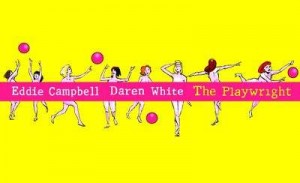Mat Brinkman’s Depressed Pit Dwellers and Heads, 44
Presumably you don’t need to be told Fort Thunder’s story all over again. That’s why I won’t be doing it at this time… You’re welcome!… I’ll add only this: those RISD students were multimedia artists drawn to many art forms: from music to comics, from assemblage to knitting. That’s why Mat Brinkman had one foot in the printing world and the other one in the art gallery milieu. He chose both, but don’t expect to find his work in the direct market venues. Most likely it’s not in there…
Instead of Fort Thunder’s story I’m going to tell you why the art form of comics needed the expression “graphic novels” (like that: in the plural form) and how it became part of our current language (you know all this already too, but I insist on my narrative because it isn’t stressed enough when people discuss what’s a graphic novel)… Chris Oliveros, the publisher of Drawn & Quarterly (ditto other alternative comics publishers, I’m sure), knew that, in order to sell his books, he needed to find alternatives to the superhero dominated direct market (in other words, he needed to flee the comics ghetto). He needed to sell in regular bookstores, but, in there, his books were lumped in with superhero comics collections and newspaper reprints. He needed to convince the BISAC to create a new label to be used in bookstores: “Graphic Novels”. This category would consist of “extended-length illustrated books with mature literary themes”, as Matthew Shaer put it in the link above. I don’t know if, a few years later, even after the creation of said category, Chris Oliveros was completely successful. According to Eddie Campbell (the creator of the hilarious Graphic Novel Manifesto): “the librarians and to some extent the book trade have decided that the graphic novel is a young readers’ genre. […] [H]ere is the sequence of events: circa 1980 [after the impact of Will Eisner’s A Contract with God and Other Tenement Stories] it was decided that comics had grown up and the grown-up version would be called ‘the graphic novel.’ [An expression coined by Richard Kyle in 1964, but with earlier uses in other languages; as all concepts its meaning changed over the years though.] This has been forgotten and […] we’re right back where we started.”
Frankly it’s not my aim to discuss the graphic novel phenomenon. To me it’s just a marketing device that I applaud because it helps to find new readers to the comics that I champion the most. Apart from that I understand Eddie Campbell when he said that the graphic novel is not a format (it’s a genre, to echo the “it’s not a genre, it’s a medium” mantra, usually applied to comics; Eddie could be absolutely right if we think that a comic book is not always comical and it certainly isn’t a book), but many different things have been called graphic novels: from a collection of short stories (Will Eisner’s A Contract With God and Other Tenement Stories) to autobiography and biography at the same time (Maus by Art Spiegelman) to journalism (Joe Sacco’s Palestine). That’s why I say that a graphic novel is a format that pretty much stands for “trade paperback” and “prestige format” in the public’s mind. That’s also why the direct market easily co-opted the expression:

Forbidden Planet, London, UK.
Continue reading →



